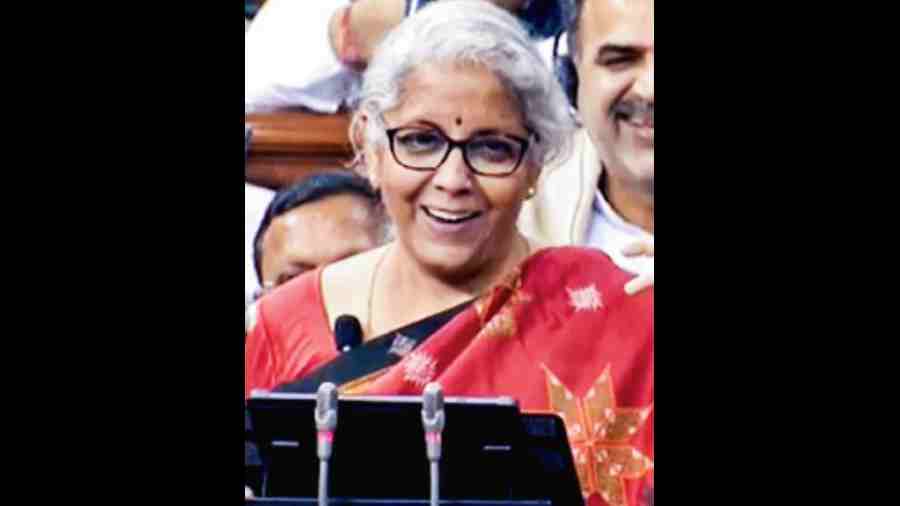Finance minister Nirmala Sitharaman has set out to balance the compulsions of populist announcements ahead of an election year with the pressures of fiscal pragmatism — and appears to have achieved an uneasy compromise on paper even though questions flew thick and fast about how quickly it could all unravel.
The government reduced the tax slabs under the new income tax regime to five, raised the limit on the rebate to Rs 7 lakh and extended the benefit of the standard deduction — in an effort to persuade taxpayers to switch to the new regime which was launched in Budget 2020 but has met with resistance because it doesn’t permit savings-related tax deductions.
Sitharaman said the new tax regime would be the default regime. The announcement sparked howls of protest from Opposition parties, forcing her to clarify at a postbudget media conference that the Modi government had no plans to compel anyone to move from the old tax regime.
“We wanted to make the new tax regime attractive for individuals,” Sitharaman said. “If the individuals find that the old tax regime is more beneficial, they are welcome to use it.”
In her speech, she had plugged the virtues of the new tax regime, saying that an individual with an annual income of Rs 9 lakh would have to fork out only Rs 45,000 by way of tax, which is a 25 per cent reduction from the existing tax payout of Rs 60,000.
There were other sops as well: the highest tax rate was reduced to an effective 39 per cent from the existing 42.74 per cent by slashing the rate of surcharge to 25 per cent from 37 per cent earlier.
The big beef with the Opposition-ruled states was that the government had not relented on the goods and services tax rates.
“No indirect taxes have been reduced. There is no cut in the cruel and irrational GST rates. There is no reduction in the prices of petrol, diesel, cement and fertilisers,” Congress leader and former finance minister P. Chidambaram said.
“It is a dark budget… full of lies, falsehoods and fake claims,” Bengal chief minister Mamata Banerjee said, adding that it would benefit “only one class of people”.
The tax foregone by the government on the tax breaks and other indirect tax reliefs amounted to Rs 38,000 crore.
Belt-tightening
Sitharaman cranked up capital expenditure in her Rs 45 lakh crore budget by 33.4 per cent to Rs over Rs 10 lakh crore from Rs 7.28 lakh crore in the BE of 2022-23.
This came as a surprise as she was still able to put a lid on the fiscal deficit at 5.9 per cent of nominal GDP for the next fiscal of Rs 301.75 lakh crore.
In absolute terms, the fiscal deficit is budgeted at Rs 17.86 lakh crore. Of this, 86.4 per cent will be funded out of gross borrowings of Rs 15.43 lakh crore with the rest coming from small savings.
The government has taken the hatchet to subsidies in an effort to balance its books — which allowed Sitharaman to crow that she had stuck to her promised glide path. “I reiterate my intention to bring the fiscal deficit below 4.5 per cent of GDP by 2025-26.”
The combined fiscal deficit for states has been capped at 3.5 per cent of gross state domestic product (GSDP) — which means general government fiscal deficit i.e Centre plus states, will be capped at 9.4 per cent.
Expenditure on food, fertilisers and petroleum — the government’s largest revenue expense after interest payments — is expected at Rs 3.74 lakh crore for FY24, 28 per cent lower than the revised estimates for the ongoing financial year.
The government will bear an expenditure of about Rs 2 lakh crore under the PM Garib Kalyan Yojana (PMGKAY) to provide free food grain to the poor and needy.
The food subsidy bill has been cut 4.58 per cent to Rs 1.75 lakh crore from Rs 2.06 lakh crore in the current fiscal, which reflects the lowering of costs after the government ended the Covid-19 era free food programme on December 31.
The government has also sharply cut back on the outlay for the Mahatma Gandhi National Rural Employment Guarantee programme under which the poor are promised 100 days of work in a year. The outlay has been slashed to Rs 60,000 crore from the Rs 73,000 crore in the BE for 2022-23, down by 17.8 per cent.
The government will actually spend Rs 89,400 crore this year, according to the revised estimates — which makes the cut sharper.













